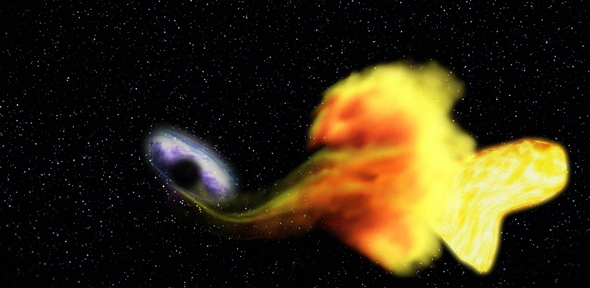Clik here to view.

The results, published in the journal Science, are based on new radio observations tracking a star as it gets torn apart by a black hole. Such violent events yield a burst of light which is produced as the bits and pieces of the star fall into the black hole. For the first time, the researchers were able to show that this burst of light is followed by a radio signal from the matter that was able to escape the black hole by travelling away in a jetted outflow at nearly the speed of light.
The discovery of the jet was made possible by a rapid observational response after the stellar disruption (known as ASAS-SN-14li) was announced in December 2014. The radio data was taken by the by the 4 PI SKY team at Oxford, using the Arcminute Microkelvin Imager Large Array located in Cambridge.
“Previous efforts to find evidence for these jets, including my own, were late to the game,” said Sjoert van Velzen of Johns Hopkins University, the study’s lead author. Co-author Nicholas Stone added that “even after they got to the game, these earlier attempts were observing from the bleachers, while we were the first to get front row seats.”
In this branch of astronomy, the ‘front row’ means a distance of 300 million light years, while previous observations were based on events at occurring least three times as far away.
Jets are often observed in association with black holes, but their launch mechanism remains a major unsolved problem in astrophysics. Most supermassive black hole are fed a steady diet of gas, leading to jets that live for millions of years and change little on a human timescale. However, the newly discovered jet behaved very differently: the observations show that following a brief injection of energy, it produced short but spectacular radio fireworks.
The observed jet was anticipated by the so-called scale-invariant model of accretion, also known as the Matryoshka-doll theory of astrophysics. It predicts that all compact astrophysical objects (white dwarfs, neutron stars, or black holes) that accrete matter behave and look the same after a simple correction based on solely the mass of the object. In other words, the larger Matryoshka doll (a supermassive black hole) is just a scaled-up version of the smaller doll (a neutron star). Since neutron stars consistently produce radio-emitting jets when they are supplied with a large amount of gas, the theory predicts that supermassive black holes should do the same when they swallow a star.
“I always liked the elegant nature of the scale-invariant theory, but previous observations never found evidence for the new type of jet it predicted,” said van Velzen. “Our new findings suggest that this new type of jet could indeed be common and previous observations were simply not sensitive enough to detect them.”
“These jets are a unique tool for probing supermassive black holes,” said co-author Dr Morgan Fraser of Cambridge’s Institute of Astronomy. “While black holes themselves do not emit light, by observing how a star is torn apart as it falls in we can indirectly study the sleeping monster at the heart of a galaxy.”
The study hypothesises that every stellar disruption leads to a radio flare similar to the one just discovered. Ongoing surveys such as the Gaia Alerts project, led by the University of Cambridge will find many more of these rare events.
“Gaia has exceptionally sharp eyes, and is ideally suited to find events like this, which occur in the very centres of galaxies,” said co-author Dr Heather Campbell, also from Cambridge’s Institute of Astronomy. “Finding more of these rare events may further our understanding of the processes that allow black holes to launch such spectacular outflows.”
Reference:
Van Velzen, S. et. al. ‘A radio jet from the optical and X-ray bright stellar tidal disruption flare ASASSN-14li.’ Science (2015). DOI: 10.1126/science.aad1182
Adapted from a Johns Hopkins press release.
An international team of astrophysicists, including researchers from the University of Cambridge, has observed a new way for gas to escape the gravitational pull of a supermassive black hole.
Image may be NSFW.
Clik here to view.
The text in this work is licensed under a Creative Commons Attribution 4.0 International License. For image use please see separate credits above.